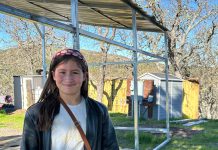An asset is a valuable possession or quality.
Everyone likes, and needs, to know that they are valued. A sense
of value leads to success.
Educators at Aromas School are focusing on asset development to
ensure the success of their students.
An asset is a valuable possession or quality.
Everyone likes, and needs, to know that they are valued. A sense of value leads to success.
Educators at Aromas School are focusing on asset development to ensure the success of their students.
“We’re trying to take a proactive approach to interventions,” said Ercilia Zavala, principal of Aromas School.
Asset development focuses on 40 assets, but a big focus is on building self-esteem.
“I’m a proponent of self-esteem. If you don’t have that in place, no matter what you tell a child, if he doesn’t think he can, he won’t,” said Maria Vallejo, a first-grade teacher at Aromas. “It’s about building connections between the students and the community.”
The Aromas staff was trying to figure out why kids were being sent to the principal’s office. The most common reasons were because of boundary issues – not respecting other people’s space – and verbal abuse, Zavala said.
The staff met and discussed how to solve these issues, as well as improve student achievement and well-being.
“We looked at the California Healthy Kids Survey and how all the assets relate to the CAT-6 and achievement,” Zavala said. “If children have breakfast or if they feel valued, scores will go up.”
CAT-6 is part of the state’s STAR test and the California Healthy Kids Survey provides essential and reliable health risk assessment to schools, districts and communities.
“We have to look at what assets we’re developing,” Zavala said. “The (students) that are getting into trouble are the ones getting attention.”
Results show that the greater the numbers of developmental assets experienced by young people, the more positive and successful their development. The fewer the number of assets present, the greater the possibility youth will engage in risky behaviors such as drug use, unsafe sex and violence, according to the Search Institute, the organization that refined asset development.
The 40 assets include: family support, caring neighborhood, community values children, adult role models, achievement expectation and motivation, caring, integrity and responsibility.
The average young person surveyed in the United States experiences only 18 of the 40 assets, according to the Search Institute. Overall, 62 percent of young people surveyed have fewer than 20 of the 40 assets, according to the institute.
This year, assets Aromas School is focusing on include self-esteem, parent involvement and making good decisions.
To combat the boundary issue, the school now has designated areas where children are and aren’t allowed. This makes it easier to supervise children and increase safety, Zavala said.
“Now, the students know where they need to be at what time,” Vallejo said.
School officials plan to focus on conflict resolution to address boundary issues and verbal abuse on campus.
Ways to accomplish asset development include supporting children, empowering them to use their abilities, setting reasonable boundaries, having high expectations, guiding children toward positive values and affirming their positive identity, according to the institute.
The Search Institute is an independent, non-profit, non-sectarian organization whose mission is to advance the well-being of children. The institute breaks assets into two categories: external assets – “the positive experiences young people receive from the world around them” and internal assets – “those characteristics and behaviors that reflect positive internal growth and development of young people,” according to the Search Institute’s Web site.
External assets identify important roles families, schools, congregations, neighborhoods and youth organizations can play in promoting healthy development, while internal assets are about positive values and identities, social competencies and commitment to learning, according to the Web site.
“We need to provide an anchor for students who may not have support at home,” Vallejo said. “We’re about making children the center of everything that goes on at this school.”
For more information on asset development, visit www.search-institute.org.









